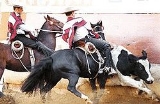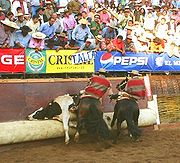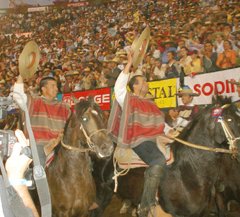
Chilean rodeo
Encyclopedia




Chile
Chile ,officially the Republic of Chile , is a country in South America occupying a long, narrow coastal strip between the Andes mountains to the east and the Pacific Ocean to the west. It borders Peru to the north, Bolivia to the northeast, Argentina to the east, and the Drake Passage in the far...
. It was declared the national sport in 1962. It has since thrived, especially in the more rural areas of the country. Chilean rodeo is different from the rodeo
Rodeo
Rodeo is a competitive sport which arose out of the working practices of cattle herding in Spain, Mexico, and later the United States, Canada, South America and Australia. It was based on the skills required of the working vaqueros and later, cowboys, in what today is the western United States,...
found in North America. In Chilean rodeo, a team (called a collera) consisting of two riders (called Huaso
Huaso
A huaso is a Chilean countryman and skilled horseman, similar to the Argentinian, Rio Grande do Sul's or Uruguayan gaucho, the American cowboy, the Australian stockman, and Mexican vaquero and charro. A female huaso is called a huasa, although the term china is far more commonly used for his wife...
s) and two horses rides laps around an arena trying to stop a calf
Calf
Calves are the young of domestic cattle. Calves are reared to become adult cattle, or are slaughtered for their meat, called veal.-Terminology:...
, pinning him against massive cushions. Points are earned for every time the steer is properly driven around the corral, with deductions for faults. Rodeos are conducted in a crescent-shaped corral called a medialuna
Medialuna
A medialuna is crescent-shaped corral used for rodeos, the official sport in Chile. They are generally 64–66 meters in diameter...
.
The sport, in its modern form, is strictly regulated. Chilean Horse
Chilean Horse
The Chilean Horse is a breed virtually unknown outside South America despite being the oldest registered native American breed, the oldest registered breed of Iberian origin, the oldest registered horse breed in South America and the oldest registered stock horse breed in the Western...
s are used exclusively and riders are required to wear traditional huaso
Huaso
A huaso is a Chilean countryman and skilled horseman, similar to the Argentinian, Rio Grande do Sul's or Uruguayan gaucho, the American cowboy, the Australian stockman, and Mexican vaquero and charro. A female huaso is called a huasa, although the term china is far more commonly used for his wife...
garb. Rancagua
Rancagua
Rancagua is a city and commune in central Chile, part of the Rancagua conurbation. It is the capital of the Cachapoal Province and of the O'Higgins Region, located south of the national capital of Santiago. It had a 2002 population of 214,344...
hosts the annual Campeonato Nacional de Rodeo
Campeonato Nacional de Rodeo
The National Championship of Chilean Rodeo is the highest-level rodeo competition in Chile.*Place: Medialuna de Rancagua*City: Rancagua*Riders with more titles: Ramón Cardemil and Juan Carlos Loaiza...
, the nation-wide rodeo championship. The greatest rider in the sport's history is considered Ramón Cardemil
Ramón Cardemil
Ramón Cardemil Moraga was a Chilean rodeo horse rider, considered one of Chile's best rodeo riders of all time. He and Juan Carlos Loaiza are the riders who have won the most titles in the Chilean National Rodeo Championship.-National Rodeo Championships:-References:...
, who obtained the national title seven times; the last champions were Juan Carlos Loaiza
Juan Carlos Loaiza
Juan Carlos Loaiza MacLeod is a Chilean rodeo horse rider. He won the Chilean National Rodeo Championship in 1987, 1988, 1994, 2000, 2001, 2002 and 2007, equalling the record of seven championship wins set by Ramón Cardemil. In 2009 he was named among the best Chilean riders of the 21st century by...
and Eduardo Tamayo. Riders practice in the countryside throughout Chile, but is most popular in the central zone
Zona Central, Chile
Zona central is one of the five natural regions into which CORFO divided continental Chile in 1950. It is home to a majority of the Chilean population and includes the three largest metropolitan areas- Santiago, Valparaíso, and Concepción...
. Even so, huasos have been known to travel hundreds of miles to compete in competitions.
The sport has become so popular that in 2004, more spectators attended rodeo events than professional football matches.
History
The birth of Chilean rodeo is placed in the 16th century during the rule of Governor García Hurtado de Mendoza. At the time, the cattle in Chile were not well identified and it was not uncommon for the animals to get lost. To help prevent the loss, Governor Hurtado proclaimed that, in Santiago, every 24th and 25 July, the commemoration of Saint Jacob - patron saint of the city -, the cattle would be gathered in the Plaza de Armas de Santiago to be branded and selected. In later years, this round-up became mandatory but, the date of the event changed to October 7, the day of Saint MarkMark the Evangelist
Mark the Evangelist is the traditional author of the Gospel of Mark. He is one of the Seventy Disciples of Christ, and the founder of the Church of Alexandria, one of the original four main sees of Christianity....
. Though the purpose of the gathering remained the same, the riders had become extremely well trained with the constant work of transferring cattle to the various corrals.
Towards the end of the 17th century, the rodeo begins to get regulated and is practiced in a rectangular track 75 meters long. The riders would bring out the cattle from the corrals and on the main track, display their abilities to separate a single calf and guide it without the help of other riders. All this activity was regulated and the most talented riders would receive honors and awards.
In the year 1860, the medialuna type track becomes the dominant track form with one apiñadero and two quinchas, where the riders have to stop the cattle. The medialuna, at this time, has a radius of 20 to 25 meters.
Standardization and regulation
During the government of General Carlos Ibáñez del CampoCarlos Ibáñez del Campo
General Carlos Ibáñez del Campo was a Chilean Army officer and political figure. He served as dictator between 1927 and 1931 and as constitutional President from 1952 to 1958.- The coups of 1924 and 1925 :...
, in 1927, a law was passed regulating the "cattle runs", placing the Chilean rodeo under the supervision of the Chilean army
Chilean Army
The Chilean Army is the land arm of the Military of Chile. This 45,000-person army is organized into seven divisions, a special operations brigade and an air brigade....
.
Rodeo became, by law, a national sport on January 10, 1962 by decree Nº269 of the National Council of Sports and the Chilean Olympic Committee. Beginning on May 22, 1961, the sport is regulated by the Federation of Chilean Rodeo
Federación del Rodeo Chileno
The Federación del Rodeo Chileno regulates rodeo events in Chile. Chilean Rodeo, officially the National Sport of Chile.Originally chartered on January 10, 1962, in Santiago....
. In 1986, the National Federation of Rodeos and Huaso Clubs of Chile (Federación Nacional de Rodeos y Clubes de Huasos de Chile) is founded to regulate, to a certain degree, the "labor rodeos" (rodeo tournaments not recognized by the Olympic Committee).
In 1949, the first National Rodeo Championship
Campeonato Nacional de Rodeo
The National Championship of Chilean Rodeo is the highest-level rodeo competition in Chile.*Place: Medialuna de Rancagua*City: Rancagua*Riders with more titles: Ramón Cardemil and Juan Carlos Loaiza...
occurs in the city of Rancagua
Rancagua
Rancagua is a city and commune in central Chile, part of the Rancagua conurbation. It is the capital of the Cachapoal Province and of the O'Higgins Region, located south of the national capital of Santiago. It had a 2002 population of 214,344...
and the very first champion was the team composed of Ernesto Santos and José Gutiérrez
José Gutiérrez
José Gutiérrez-Guerra, known as "the last Oligarch," was President of Bolivia between 1917 and 1920....
. The riders with the most victories in the history of the championship are Ramón Cardemil
Ramón Cardemil
Ramón Cardemil Moraga was a Chilean rodeo horse rider, considered one of Chile's best rodeo riders of all time. He and Juan Carlos Loaiza are the riders who have won the most titles in the Chilean National Rodeo Championship.-National Rodeo Championships:-References:...
and Juan Carlos Loaiza
Juan Carlos Loaiza
Juan Carlos Loaiza MacLeod is a Chilean rodeo horse rider. He won the Chilean National Rodeo Championship in 1987, 1988, 1994, 2000, 2001, 2002 and 2007, equalling the record of seven championship wins set by Ramón Cardemil. In 2009 he was named among the best Chilean riders of the 21st century by...
, each having won the national title seven times. The most recent champions of the 2007-2008 season were Jesus Rodriguez
Jesús Rodríguez
Jesús Rodríguez may refer to:*Jesús Rodríguez Tato , Spanish football player*Jesús Eugenio Rodríguez , Cuban sport wrestler*Jesús Rodríguez , Venezuelan javelin thrower...
and Christian Pooley.
Although the Chilean rodeo was declared a national sport, it finds itself in a precarious position in terms of finances, political support and promotion. Part of the reason for this is that the federation does not receive any of the revenue of Chiledeportes like the rest of sports federations in Chile. This is because only sports that represent Chile overseas receive funds. The Chilean Rodeo Federation has been critical of the government for the lack of funds towards the sport, arguing that because in many parts of the country, due to the distance from population centers, sporting events do not arrive, the local population turn to the rodeo as their primary pass time throughout the Chilean rural territory. Nevertheless, thanks to the commitment and support of its many fans, the rodeo has maintained its popularity, especially in the rural areas, and its status as the second most popular sport in Chile.
Criticism
Animal rights organizations object to Chilean Rodeo and refuse to call it "sport". The arguments against this activity are related to the treatment the animals receive: the calf is driven near a wall and suddenly is hit by the horse's chest (a charge) in order to stop him. This occurs several times, although the calf is rarely injured or unwilling to stand up. There are constant "inspections" of the calf during the event to ensure that it is fit to continue.In 2006, a group of 40 people protested against Chilean rodeo outside Medialuna de Rancagua where the Campeonato Nacional de Rodeo
Campeonato Nacional de Rodeo
The National Championship of Chilean Rodeo is the highest-level rodeo competition in Chile.*Place: Medialuna de Rancagua*City: Rancagua*Riders with more titles: Ramón Cardemil and Juan Carlos Loaiza...
(National Championship of Chilean Rodeo) was taking place.
In 2010, a group of activists entered a medialuna in the middle of a rodeo to protest, and they were violently repressed by the huasos taking part in the event. A 17 year old girl was lassoed, beaten and dragged out of the medialuna.
Since then, other organizations are seeking a ban on Chilean rodeo. This is similar to the 2010 ban on Spanish bullfighting in Catalonia
Ban on bullfighting in Catalonia
Bullfighting was banned in the Spanish region of Catalonia by a vote of the Catalan Parliament in July 2010. The ban comes into effect on 1 January 2012...
, Spain.
External links
- National Sport
- Chilean Rodeo
- Portal del Rodeo Chileno (text in Spanish)

